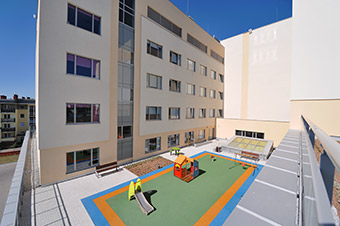Current Activities and Development
Market development prospects
 Szpital Dziecięcy w BydgoszczyIn line with the expectations, in 2014 the strong downturn trend in the construction sector was reversed. The upward trend will probably be maintained also in 2015 and subsequent years. Settlement of new contracts financed partly from the European Union budget within the framework of the new financial perspective for the years 2014-2020 will be crucial. Efficient use of European funds is the factor that will determine the dynamics and directions of development of the construction sector in Poland in the coming years. One must positively asses the achievement of main milestones on this way, such as: arranging a Partnership Agreement with the European Commission, completion of negotiations concerning the Infrastructure and Environment Operational Programme 2014–2020 and approval of parts of Regional Operational Programmes. The coordination of regional investments will be facilitated through the approval and conclusion of Territorial Contracts for 2014–2023, guiding activities of the government and local governments towards specific needs and investment priorities of each region. The total amount of funds allocated to member states in the 2014–2020 financial perspective for the cohesion policy will reach approx. EUR 350 billion. The main beneficiary of EU funds will be Poland who may expect total support in the amount of
EUR 82.5 billion. The largest operational program will remain Infrastructure and Environment Programme with allocation at the level of EUR 27.4 billion under which the priority is a low-carbon economy, environmental protection, development of national technical infrastructure and energy security. In accordance with the Programme approved by the European Commission in December 2014, it can be expected that the largest amount of funds will be allocated to transport-related projects — roads, railway, urban transport, air transport and sea transport (allocation of approx. EUR 19.8 billion). The above sectors will be followed by: environmental sector (EUR 3.5 billion) and energy sector (EUR 2.8 billion). The main recipients of the support will be public sector entities, including local government units and entrepreneurs, in particular large companies.
Szpital Dziecięcy w BydgoszczyIn line with the expectations, in 2014 the strong downturn trend in the construction sector was reversed. The upward trend will probably be maintained also in 2015 and subsequent years. Settlement of new contracts financed partly from the European Union budget within the framework of the new financial perspective for the years 2014-2020 will be crucial. Efficient use of European funds is the factor that will determine the dynamics and directions of development of the construction sector in Poland in the coming years. One must positively asses the achievement of main milestones on this way, such as: arranging a Partnership Agreement with the European Commission, completion of negotiations concerning the Infrastructure and Environment Operational Programme 2014–2020 and approval of parts of Regional Operational Programmes. The coordination of regional investments will be facilitated through the approval and conclusion of Territorial Contracts for 2014–2023, guiding activities of the government and local governments towards specific needs and investment priorities of each region. The total amount of funds allocated to member states in the 2014–2020 financial perspective for the cohesion policy will reach approx. EUR 350 billion. The main beneficiary of EU funds will be Poland who may expect total support in the amount of
EUR 82.5 billion. The largest operational program will remain Infrastructure and Environment Programme with allocation at the level of EUR 27.4 billion under which the priority is a low-carbon economy, environmental protection, development of national technical infrastructure and energy security. In accordance with the Programme approved by the European Commission in December 2014, it can be expected that the largest amount of funds will be allocated to transport-related projects — roads, railway, urban transport, air transport and sea transport (allocation of approx. EUR 19.8 billion). The above sectors will be followed by: environmental sector (EUR 3.5 billion) and energy sector (EUR 2.8 billion). The main recipients of the support will be public sector entities, including local government units and entrepreneurs, in particular large companies.
In accordance with the assumptions of the act on state budget, the GDP growth in 2015, in real terms, should amount to 3.4% and the average annual inflation rate should amount to 1.2%. The unemployment rate at the end of 2015 is projected to be 11.8%. Prospects for the development of the construction market for 2015 are stable with some growth perspective. Much higher growth dynamics, resulting from accumulation of construction works under contracts co-financed from the new EU perspective, should be expected in 2016–2018.
New priorities and challenges are currently being specified in the road construction segment. A draft National Roads Construction Programme (Program Budowy Dróg Krajowych, PBDK) for the years 2014–2020, for which the public consultations were completed in January 2015, stipulates that the amount spent for investment tasks specified in an appendix to PBDK will be PLN 92.7 billion. In the first place, these funds will be used for the construction of 1,862 km of express roads and motorways, as well as 366 km of ring roads specified in appendix No 1 to draft PBDK. In the event of obtaining additional funds or savings, additional 630 km of express roads and motorways and 147 km of ring roads may be approved for implementation from the pool of reserve projects. Part of large road projects included in draft PBDK for the years 2014–2020 and projects requiring completion from PBDK for the years 2011–2015 were allocated by the General Directorate for National Roads and Motorways already in 2014 (46 tasks). The total value of lowest bids exceeded PLN 13.5 billion. In January 2015, other bids were opened in next 5 large tenders, with the total value of nearly PLN 2.9 billion.
The main risk factors in the infrastructure construction market still include price competition and risk of accumulation of works in 2016–2018 which may result in the mobilisation of sufficient capital, personnel and material resources.
Investments in the railway infrastructure sector did not reach the dynamics assumed in the Long-term Railway Investment Programme until 2015, although they set a new record. It is assumed that expenditure of the main investor in this segment of the construction market, PKP PLK, exceeded PLN 7 billion in 2014. 2015 is expected to bring another increase in expenditure, amounting even up to PLN 9–10 billion, however it will still relate to project co-financed from the last financial perspective of the European Union. The rate of announcing and awarding material tenders under the new financial perspective is unsatisfactory which, in the period 2016–2017, may entail a risk of market contraction and problems for companies with extensive executive potential.
In the long term, prospects for the railway construction sector are relatively good. Only in the priority axis 5, dedicated to the development of railway transport in Poland, under the Infrastructure and Environment Operational Programme for the years 2014–2020, the allocation is to amount to over EUR 5 billion. Moreover, it is expected that more funds for railway projects will be received under the “Connecting Europe” Facility, to which 6 projects with the total value of PLN 10.2 billion are to be submitted in the first place. These projects were approved by the government in July 2014. Polish allocation to the “Connecting Europe” Facility (the so-called national envelope in the transport sector) amounts to EUR 4.1 billion, of which major part is planned to be used in the railway transport.
The energy-related construction segment will probably maintain good growth performance due to large projects for the construction of several power units which entered the implementation phase almost simultaneously. The Energy Regulatory Office (Urząd Regulacji Energetyki, URE) estimates that by the end of 2028, 18 GW of new production capacities are to be commissioned. Although the largest contracts have already been awarded, over a dozen of major investments in the broadly understood conventional energy sector is still at the planning or tender stage. Moreover, the importance of the renewable energy market will increase, in particular with respect to wind energy. The essential role in this aspect will be played by the stabilisation of the regulatory environment, in the form of a new act on renewable energy sources which is currently at the stage of legislative work.
It seems that perspectives are stable for the transmission and distribution market of electric energy and gas. The transmission system operator and largest operators of the distribution system established with URE an investment programme for the years 2014–2019 in the amount of approx. PLN 42 billion, and the gas transmission operator declares that it will allocate over PLN 7 billion to investment expenditures in the years 2014–2018. From the contractors’ perspective, tender terms will probably be of key importance for the stability of these sub-segments of the market.
2015 may again bring an increase in the number of investments in property development companies. The offer of the primary market combined with the expected maintenance of good economic growth should cause the maintenance of positive trends from 2014. However, the maintenance of a comparable number of transactions may be difficult. The biggest players present in large Polish cities and providing an offer adopted to expectations of the market have probably the greatest changes for further growth. Factors that may affect the shape of the market in 2015 may include, on the one hand, new limits under the MdM programme and increasing adaptation of the development offer to those limits and, on the other hand, increase in the minimum own contribution to mortgage loans which may result in a limited availability of loans for a certain number of customers.
The opportunity of further development of the infrastructure market may be also based on the public-private partnership (PPP) formula. PPP is still applied in Poland to a very limited degree, usually with respect to small projects. We can celebrate some small successes which build up the catalogue of best practices and verified solutions acceptable by public entities, private partners and the banking sector, however unfortunately there are still too few of them. A great importance to PPP and its role in the cohesion policy for the years 2014–2020 is also attached by the European Union which, in the general regulation specifying the rules for the disposition of funds in the new perspective, promotes combining PPP with European funds under the so-called hybrid PPP projects which may be a good solution, in particular for projects with lower profitability for private partners.
Budimex Group development perspectives in the forthcoming year
Next year the Budimex Group will continue to operate in all major sectors of the construction market in Poland, as well as on the German market.
New infrastructural investments (in particular road investments implemented under the National Roads Construction Programme for the years 2014–2020) offer an opportunity for the Budimex Group to win contracts in this segment.
The Group also plans to win contracts in the facilities, energy and hydraulic engineering construction segments. Further development on the market of municipal services is also planned, as well as engaging in new projects on the basis of public-private partnerships.
In 2014, the Budimex Group companies signed construction contracts for the total value of PLN 6,310 million (with annexes). The value of the construction order portfolio of the Budimex Group as at 31 December 2014 amounted to PLN 6,107 million and was by 40.7% higher in comparison with the end of 2013.
The structure of the order portfolio as at 31 December 2014 is as follows:
Evaluation of investment projects feasibility
In 2015, the Budimex Group plans to incur capital expenditure of approx. PLN 68 million. The outlays will be made mainly on construction machines and implementation of IT solutions.
Capital expenditure will be financed from own funds and from external sources.
